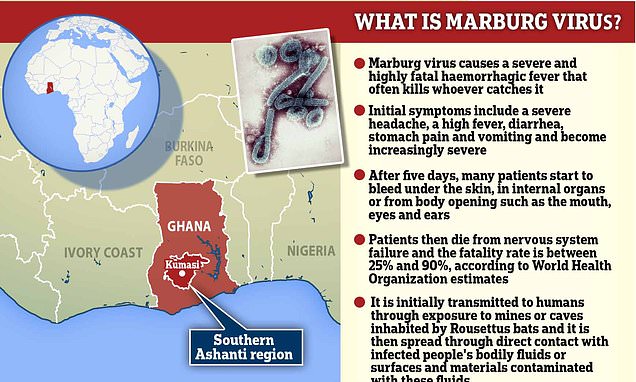Fears over new outbreak of one of world’s deadliest diseases in Africa: Two patients ‘die from Marburg virus’ that causes 90% of patients to bleed to death from their nose, mouth and eyes
- Patients not known to each other which suggests virus is spreading more widely
- World Health Organization deploying experts to support Ghanaian health chiefs
- Marburg one of deadliest viruses known to exist, killing up to 88% of sufferers
Two people are believed to have died from the extremely deadly Marburg virus in Ghana as officials gear up for a potential outbreak.
The patients, from the country’s southern Ashanti region, were not known to each other, suggesting the disease is spreading more widely.
Initial tests came back positive for the virus and the samples are being reanalysed by the World Health Organization (WHO).
If confirmed, it would mark only the second time Marburg has been detected in West Africa, after a small outbreak in Guinea last year.
The WHO is sending experts to support Ghanaian health officials and track down the close contacts of the victims.
A deadly cousin of Ebola, Marburg kills between a quarter and 90 per cent of everyone who gets infected.
The highly-infectious pathogen has been touted as the next big pandemic threat, with the WHO describing it as ‘epidemic-prone’.
Infected patients become ‘ghost-like’, often developing deep-set eyes and expressionless faces. This is usually accompanied by bleeding from multiple orifices — including the nose, gums, eyes and vagina.

Two people are believed to have died from the extremely deadly Marburg virus in Ghana as officials gear up for a potential outbreak. The patients were from the country’s southern Ashanti region and were not known to each other, suggesting the disease is spreading more widely

Two people are believed to have died from the extremely deadly Marburg virus in Ghana
Dr Francis Kasolo, the WHO representative in Ghana, said: ‘The health authorities are on the ground investigating the situation and preparing for a possible outbreak response.
‘We are working closely with the country to ramp up detection, track contacts, be ready to control the spread of the virus.’
Officials said the two Ghanaian patients suffered diarrhoea, fever, nausea and vomiting. Their ages and sex have not been revealed.
Analysis of samples taken from two patients by the country’s Noguchi Memorial Institute for Medical Research came back positive for Marburg.
They have now been sent to the Institut Pasteur in Senegal, a WHO Collaborating Centre, for confirmation. It would make the pair Ghana’s first Marburg cases.
The virus is normally associated with outbreaks in Angola, the Democratic Republic of the Congo, Kenya, South Africa and Uganda.
The WHO is deploying experts to support Ghana’s health authorities by bolstering disease surveillance, testing and contact tracing.
Officials will also work with communities to alert and educate them about the dangers of the disease and to collaborate with the emergency response teams.
Marburg is a viral haemorrhagic fever in the same family as the more well-known Ebola virus disease.
The virus is carried by fruit bats but can be spread between humans through blood and bodily fluids, as well as touching contaminated surfaces.
Extremely stringent infection control measures are needed to contain the virus.
It was first detected in humans in 1967 after outbreaks in Marburg and Frankfurt in Germany and in Belgrade, Serbia, after being passed to lab workers by monkeys imported from Uganda.
The disease was detected a second time in 2008 in a Dutch woman who returned to the Netherlands from Uganda, where she had been visiting caves.
Illness begins abruptly, with high fever and severe headache, often leading to severe bleeding within seven days.
There are no vaccines or antiviral treatments approved to treat the virus so doctors have to rely on intravenous drips to improve symptoms.
A range of potential treatments, including blood products, immune therapies and drug therapies are still being developed.
What is Marburg virus?
Marburg virus causes a severe and highly fatal haemorrhagic fever that often kills whoever catches it.
Initial symptoms include a severe headache, a high fever, diarrhoea, stomach pain and vomiting and become increasingly severe.
In the early stages of the disease, it is very difficult to distinguish from other tropical illnesses that cause fevers, such as Ebola and malaria.
After five days, many patients start to bleed under the skin, in internal organs or from body opening such as the mouth, eyes and ears.
There is currently no cure for the disease, so patients are monitored and treated with fluids.
Studies are currently trialling antibody treatments and antivirals, but these can only be given as part of the trials, according to WHO.
Patients then die from nervous system failure and the fatality rate is 50 per cent, according to World Health Organization estimates.
Marburg fatality rates in past outbreaks have varied from 24 per cent to 88 per cent of those infected.
It is initially transmitted to humans through exposure to mines or caves inhabited by Rousettus bats and it is then spread through direct contact with infected people’s bodily fluids or surfaces and materials contaminated with these fluids.
Source: World Health Organization
Source: Read Full Article
